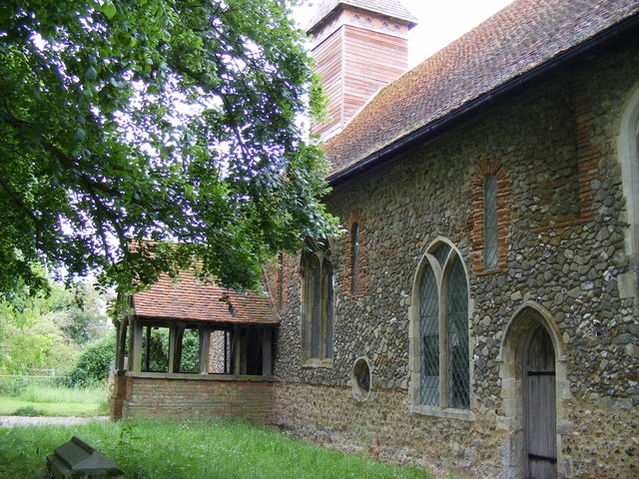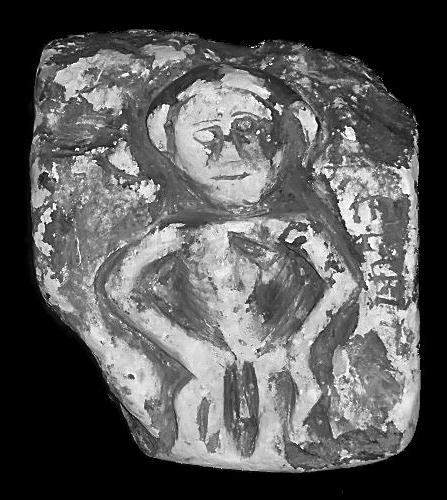Easthorpe is a small village and civil parish in the Colchester
District of Essex. It is on an old Roman road. Nearby settlements
include the large town of Colchester and the villages of Marks Tey,
Copford and Copford Green.
The church of ST. MARY, Easthorpe Road, the dedication of which
was recorded in 1427, was built of mixed materials with Roman brick
in the dressings, and has an undivided nave and chancel with a west
bell turret and spire of timber.
The nave and west end of the chancel, which originally had an
apse, are 12th-century and of that period are all or part of five
windows and north and south nave doorways. In the mid 13th century
the apse was destroyed and the chancel lengthened: it has an east
triplet of lancets and sedilia, both enriched, and a piscina.
Paintings in the splays of a nave window may also be 13th-century.
The east end of the nave and west end of the chancel were mostly
refen- estrated in the 14th century, a west window inserted, and a
tomb recess, which incorporates a quatrefoil window, was made in
the nave south wall. In the 15th century the porch, recon- structed
in 1910, and a stoup were added, as was a rood loft from which
rood-stair doorways remain.

In 1685 the floor needed mending in several places and the tiled
roof needed repair. One nave window seems to date from the 16th or
17th century and the communion table is 17th- century. There was
presumably a west bell- turret by 1705 when the steeple needed
shingling. It was repaired in 1866 and in 1910. By 1892 the nave
roof and walls and the porch were in poor condition, and the church
was extensively restored in 1910-11 by F. Hutton of Birch, builder,
to plans by Wykeham Chan- cellor.
The walls were repaired, especially the north wall where a
buttress was built, a new roof was constructed, the tower was
straightened and the north doorway was reopened. The old vestry was
removed. The church was reseated with chairs and re-floored and a
pulpit was provided.
In the tomb recess window is stained glass with several coats of
arms; there are also remains of arms in a chancel south window. In
1831 there was in a north window a figure of an armed knight, with
a red cross on his breast, supported under his arms by two angels,
his helmet being removed by another angel.
Members of the Kingsmill family, buried in the chancel, are
commemorated by floor slabs. There is a medieval
scratch-dial.
The church sustained minor damage in the Second World War. The
tower was damaged in a gale c. 1969, and subsequently
restored.
Two bells were sold at the Reformation. Two bells were recorded
in 1867 and 1877, one of which was of 1663 by Miles Gray, which
survived in 1909 and was an exact duplicate of the single bell at
Abberton.
The plate included a small Elizabethan silver chalice and cover;
a pewter flagon was recorded in 1685.

The Easthorpe Sheela currently resides in the Castle Mueseum in
Colchester but originally came form the small parish church in
nearby Easthorpe. It was donated to the museum by the vicar of the
church early in the 20th century as he thought it too "obscene" to
keep in the church. The figure was originally kept above the south
doorway in an alcove but also served time as an ornament in the
garden rockery of the vicarage. Once again we have classic position
for a sheela above or near entrances to the church, however it is
possible to make too much of this positioning as the alcove may
just have been a convenient place to put the carving. Interestingly
this sheela has the word ELUI carved down the right hand side. The
significance of this name is now lost however both Barbara Freitag
and Jorgen Andersen put forward theories on the possible meaning of
the name, With Andersen citing a possible connection, to St Eloi
and Freitag giving several possible connections.
The figure stands with bent knees, both hands gesture towards
the oversized vulva which reaches to below the feet and seems to
include a clitoral hood. The figure has faint ribs inscribed on
both sides of the chest and also appears to be wearing a headdress
or cap. The "ears" either side of the head are over large but could
equally be part of the headdress.
The carving is made of clunch being a form of gritty grey chalk.
According to local historian A R West the stone is not native to
the area which would mean either the stone was imported or the
carving has come from elsewhere. It's curious that it should be
named after the material it was made from rather than the subject
matter.
The Thorpe in Easthorpe is thought to derive from the Saxon word
Thorp meaning hamlet or farm. In the time of Edward the confessor
it was held by one Eadric a freeman. The doomsday book records the
village as Estorp being held by Hugh an under-tenant of Count
Eustace of Boulogne. The successors of Hugh held the village until
the late 12th century when it was granted to the Gernon family. The
church originally had a semicircular apse which was demolished in
the 13th century. Much of the remaining fabric of the church is
Norman and a number of windows still exist from that period. Its
difficult to say whether or not the sheela figure is an original
part of the church. The carving is fairly small and highly portable
and the material from which it is made is not local to the area.
Other figurative carving on the church is in a different style and
appears to be of a much later date. There are however fragments of
dressed and molded stone work embedded in the outside walls of the
church. Its hard to say whether these came from an earlier
incarnation of the church or elsewhere but the re-used round window
would seem to suggest that fragments from other buildings have been
incorporated into the building.
If anybody would like to expand to this series please do, I
would just ask that you could let
Sadexploration know first so he can keep track of the Church
numbers and names to avoid duplication